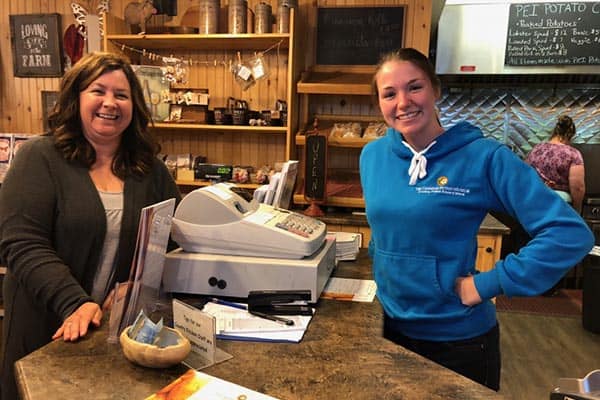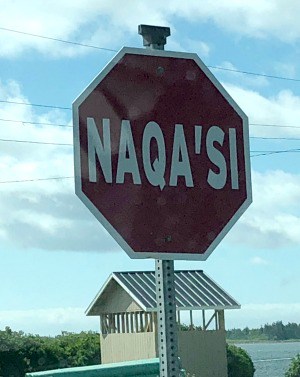
Prince Edward Island is a Gem…A Wonderful Island Full of Surprises
By Max Hartshorne
GoNOMAD Editor

Prince Edward Island has always been a place of mystery and intrigue for me. It’s an island, it’s its own province, and everybody knows it by its initials–PEI.

I have visited Nova Scotia, New Brunswick, Gaspesie, and Quebec, but until this week, never set foot on this magnificent island stretching 140 miles across. As with so many places, I came away totally impressed and wanting to return.
PEI is the about the size of the state of Delaware, with just 142,000 residents and a whole lot of potato fields.
A quarter of Canada’s potatoes are grown in the fertile fields of PEI, they even have a potato museum with a restaurant that serves lobster stuffed spuds!
Why Prince Edward Island?
PEI is an island of significant size and few people. Flying over the island on our way here from Halifax Nova Scotia, and looking down, I saw nothing but the green of pine trees and the outlines of brown sandy beaches and a patchwork of green and ochre fields, carefully divided by stone walls and hedges.

No houses, no roads, and no signs of people. As we drove the length of the island from Charlottetown to the West End, in the middle/east, to the West End, dotted with wind power turbines and replete with stellar views of the ocean and the red cliffs, I thought about how much room there is here.
READ ANNE OF GREEN GABLES SITES ON PEI
You could take a city full of people and drop them here and they’d disappear into the forests and fields.
Listening to the sound of crashing waves about twenty feet from my window, in the West Point Lighthouse hotel, on the far western side of the island was a treat. On our way to dinner, we met members of a local family named Wagner who are all involved in the food business here.
Eric, the father, is a former fisherman who now owns the Moth Lane Brewing Company in Ellerslie, his daughters Erika and Courtney, own their own restaurants in different towns on PEI. He held up a pair of vice grips, calling them a PEI Hammer.
Eric was helping daughter Courtney create a new ice cream window at her restaurant, The Catch, in West Point. Things got a bit busy so they couldn’t get it all done, but the young manager of the West End Lighthouse Hotel, Scott, was very enthusiastic about their plans.
Not open yet, but soon I’m sure there will be a line of tourists and locals waiting for ice cream at the new window soon.

Lennox Island Mi’kmaqs
We began our day on Lennox Island, home of the Mi’kmaq tribe, who are developing a new program that shares their native crafts with visitors.
We were there to learn how to make a Mi’kmaq drum out of deer hide and a circle of wood the size of a tambourine.
Under the watchful eyes of Misty and Chase, we began by folding the hide into half circles and then quarter circles and then punching holes around the hide, through which strips of hide would be woven.
The hide wetted so that it would stretch, and we learned that after it was done, in 24 hours or so it would all harden up to create the tension needed to create the drum sounds.
“Your drum holds all of your experiences,” Misty told us, “so bring it with you everywhere you go. The drum is the repository of your life experiences, it has your history inside it, so share what you do with your drum.”
The tribe has been through a lot, but in recent years has seen a decline in rampant alcoholism and drug use that once plagued the tribe.
More First Nations people are willing to help their fellow tribe members, which has caused a remarkable turn around in this regard. It’s still a problem but one that seems to have tamed itself, we were told.
A few years ago, tribal leaders introduced a new program to re-teach native crafts like basket weaving, drum making, porcupine quill earrings, and other crafts that most members used to know well. Today you can make a drum, enjoy a traditional clambake on the beach, or learn how to make art using porcupine quills, as part of the tribe’s outreach program. website
Oysters on Tap at Valley Pearl

One of the best things we discovered about PEI was the many people who have left their previous occupations to focus on their passions. One man like this is Jeff Noyes, who have opened an oyster tasting room in Tyne Valley with partner Damien Enman.
Tyne Valley has about 800 residents and has always been ‘an oyster village,’ said Noyes.

Noyes spent 15 years as a teacher, and the same amount of time as the head organizer of the village’s annual oyster festival, that brings 20,000 visitors to the town every July.
“There’s nothing I’d rather be doing than shucking oysters!” he said, as he served up a plate of the sumptuous Malbeque oysters that are harvested from the bottom of the local lagoon, not farmed as most of the bivalves are in PEI.
“They taste like the beach!” Jeff exclaimed as we began slurping the oysters, harvested yesterday in Malbeque, on the west coast of PEI.
New Tasting Room
Jeff and Damien are excited about their new oyster tasting room, that opened in summer 2018, where people can enjoy these perfectly fresh local oysters paired with local brews. He showed us the $150,000 machine that they bought that sorts each oyster according to size and weight, doing the work of four people and a better sorting job.
I asked Jeff about those $1 oysters that are offered at some Charlottetown bars. “Yeah, those are the ones we would reject,” he explained, “because they would have a softer shell and when they’re shucked you get pieces in with the meat.”

A Lobsterman Up Close
Another man we met on the island who is pursuing a dream is Mark Jenkins, who has been a fisherman for a few decades. He’s an active lobsterman, runs a charter fishing boat, and takes visitors and locals out on Top Notch Lobster Tours.

We learned all about the lobster and tuna fishery here on PEI, and happily, it’s good news for everyone. Due to strict conservation, lobster stocks are robust, and now they have brought in catch-and-release, the tuna are plentiful too.
“Each fisherman is allowed to catch one tuna per season,” Jenkins explained, as we trolled the outer Charlottetown Harbor en route to our anchorage close to the far shore.
The tours start at 2 pm daily and include catching lobster, pulling crab traps, and a cold lobster meal. “In PEI, we like to eat the lobster cold,” he explained.
Jenkin’s Tour is especially interesting because he is well-spoken and is passionate about the PEI fishing culture, and the preservation of the tuna and lobster stocks. “If some lobsterman is cheating, we want the feds to catch them!” he said.
He added that if a fellow lobsterman breaks the rules, and drops his traps in someone else’s area, those traps will be cut and sunk to the bottom.

We made our way across the island over well-maintained roads, to West Point, where wind farms are abundant, with the turbines spinning above us stretching out over the horizon. There are many wind farms here and the 200+ turbines provide a quarter of all the electricity used by PEI residents.
There is a museum dedicated to wind power at this far tip of the island, called the North Cape. The North Cape Interpretive Centre offers a wind turbine blade up close, plus a red sand beach that’s covered with man-made cairns. Spooky and fun.

Lighthouse Living
There are sixty-one lighthouses on Prince Edward Island, including one that’s attached to a hotel. We enjoyed a ‘close to the beach as possible’ room stay at the West Point Lighthouse Inn in O’Leary.
At West Point, not only can you climb all the way up the narrow stairs and squeeze through a metal hatch to view the beach and surrounding forestland from up high, you can actually sleep in the lighthouse!
There are two guestrooms at the West Point Lighthouse Inn, and both are very popular. We met a mother and daughter from California who said they come here every July to sleep in these beds!
Inn manager Scott shared with us how he’s climbed these stairs as many as 16 times per day showing guests the marvelous views and history they find at the top of the lighthouse tower.

Beaches in PEI
The island is blessed with dozens of gorgeous sandy beaches, including the wonderful views of PEI National Park in North Rustico and Cavendish.
The dramatic red sandstone cliffs are an emblem of the island…most beaches even when we visited in July were mostly empty.
We walked the beach at Dalvay where kids played with trucks and the water was warm enough to swim. The influence of the Gulf stream brings water temperatures down up here, surprising when you consider how cold the water is in nearby Maine or New Brunswick.
Though the summer and fall are lovely, we were told about what it’s like here some winters when the snow is deep. It’s really cold and it snows A LOT, we learned. It’s probably best to plan your Prince Edward Island trip during the warm months, but it’s definitely worth the trip!
Find out more about visiting Prince Edward Island from Tourism PEI.
Our trip was sponsored by Tourism PEI but the opinions expressed are the author’s own.
- Exploring California’s Empty Central Coast - April 24, 2024
- Skiing in Georgia - February 21, 2024
- Exciting Rail Travel News in 2024 - February 4, 2024







Great Story Max!
Thanks, Paul, as someone who has traveled up that way more than I have, I appreciate that!